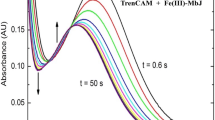Abstract
Mycobactin J-1, an iron chelate fromMycobacterium paratuberculosis, was characterized by mass spectrum and by1H nuclear magnetic resonance (NMR) and13C NMR spectra of the parent molecule and of cobactin J-1. The core structure of mycobactin J-1 contained the phenyloxazoline ring system common to the mycobactins. The benzene ring was disubstituted. The two hydroxamate functions were furnished by 1 linear 6-N-hydroxylysine residue and 1 cyclic 6-N-hydroxylysine residue as in other members of this class of compounds. The acyl function at the mycobactic acid hydroxamate center wasn-cis-hexadec-2-enoyl. The hydroxyacid of the cobactin portion of mycobactin J-1 was 2,4-dimethyl-3-hydroxypentanoic acid. This latter residue differs from those of other known mycobactins by the presence of the isopropyl group.
Similar content being viewed by others
Literature Cited
Chamberlain, N. F. 1974. The practice of NMR spectroscopy. New York: Plenum Press.
Greatbanks, D., Bedford, G. R. 1969. Identification of mycobactins by nuclear-magnetic-resonance spectroscopy. Biochemical Journal115:1047–1050.
Merkal, R. S. 1979. Proposal of ATCC 19698 as the neotype strain ofMycobacterium paratuberculosis Bergey et al. 1923. International Journal of Systematic Bacteriology29:263–264.
Merkal, R. S., McCullough, W. G. 1982. A new mycobactin, Mycobactin J, fromMycobacterium paratuberculosis. Current Microbiology7:333–335.
Snow, G. A. 1954. Mycobactin. A growth factor forMycobacterium paratuberculosis. II. Degradation and identification of fragments. Journal of the Chemical Society49:2588–2596.
Snow, G. A. 1965. The structure of mycobactin P, a growth factor forMycobacterium johnei, and the significance of its iron complex. Biochemical Journal94:160–165.
Snow, G. A. 1965. Isolation and structure of mycobactin T, a growth factor fromMycobacterium tuberculosis. Biochemical Journal97:166–175.
Snow, G. A., White, A. J. 1969. Chemical and biological properties of mycobactins isolated from various mycobacteria. Biochemical Journal115:1031–1045.
White, A. J., Snow, G. A. 1968. Methods for the separation and identification of mycobactins from various species of mycobacteria. Biochemical Journal108:593–597.
White, A. J., Snow, G. A. 1969. Isolation of mycobactins from various mycobacteria. Biochemical Journal111:785–792.
Author information
Authors and Affiliations
Rights and permissions
About this article
Cite this article
McCullough, W.G., Merkal, R.S. Structure of mycobactin J. Current Microbiology 7, 337–341 (1982). https://doi.org/10.1007/BF01572600
Issue Date:
DOI: https://doi.org/10.1007/BF01572600




